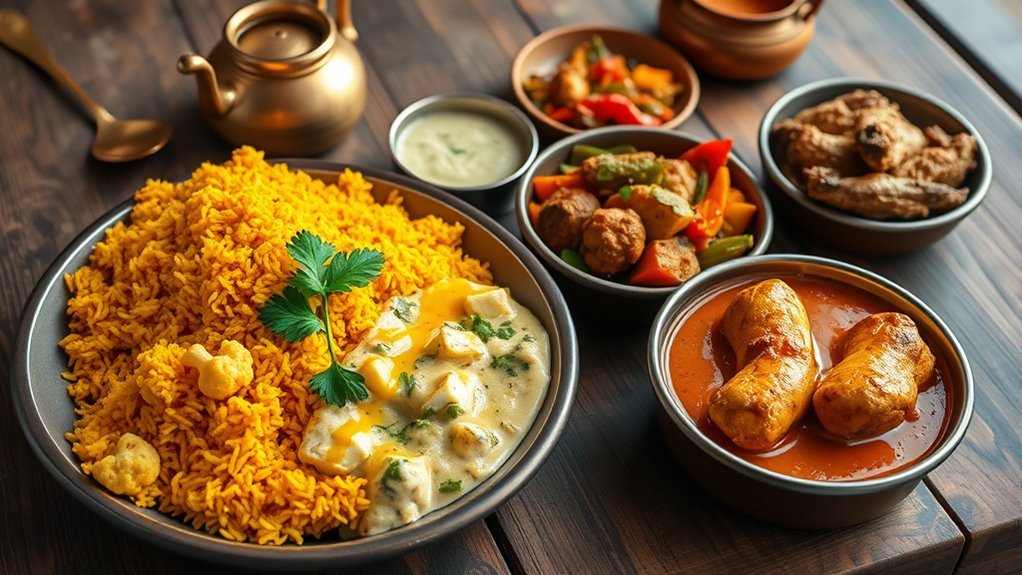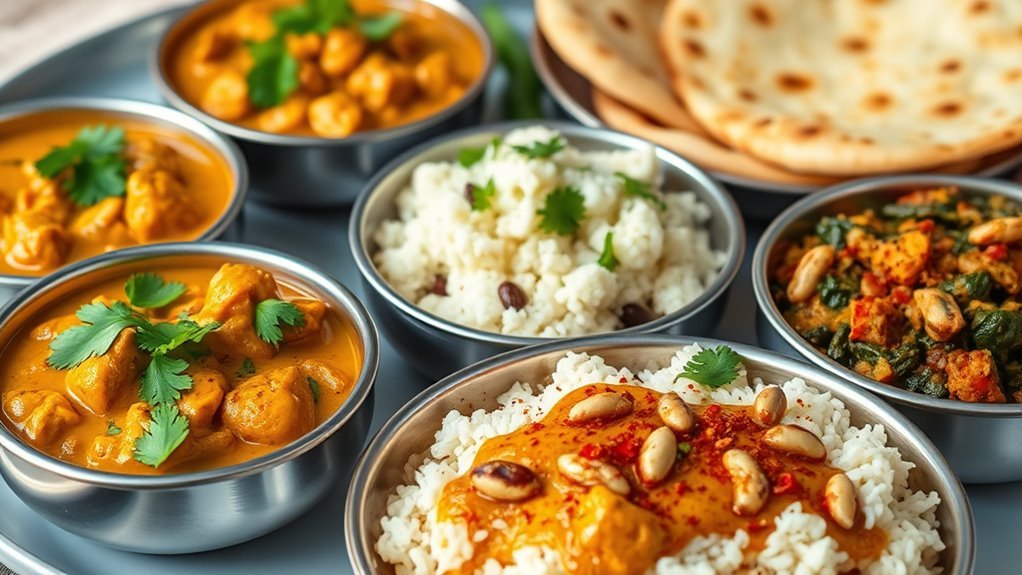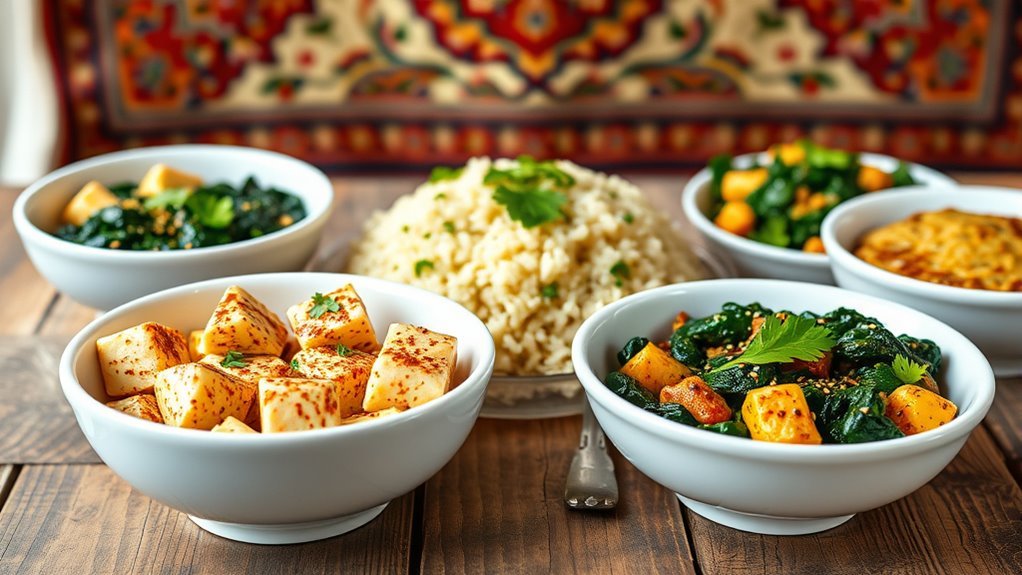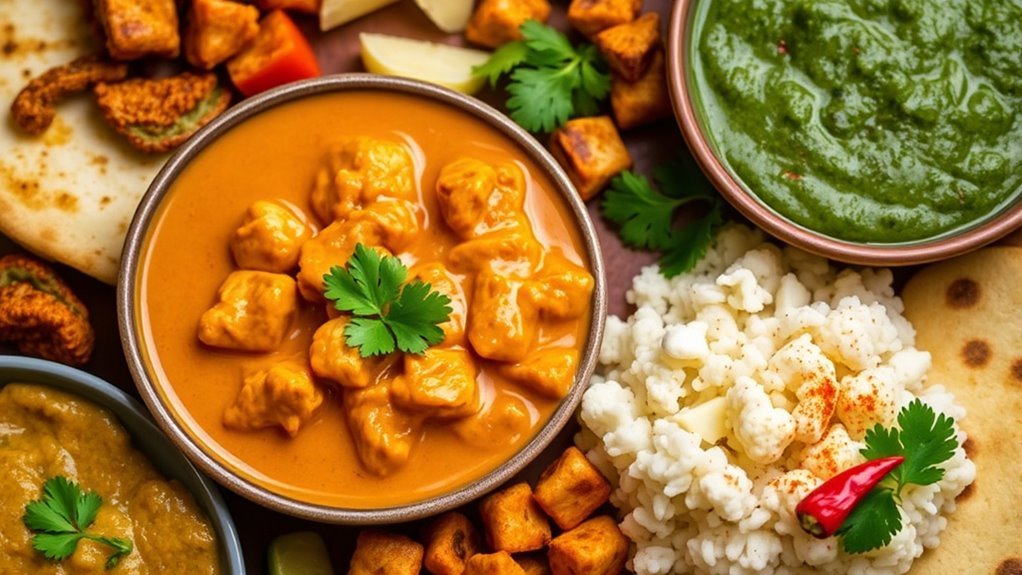Yes, you can enjoy Indian food on a keto diet by making some smart substitutions. Focus on dishes that use proteins like chicken, fish, or paneer, and healthy fats like coconut oil or ghee. Opt for low-carb vegetables and replace rice with cauliflower rice. Be cautious with high-carb foods like naan and rice dishes. With thoughtful modifications, you can savor Indian flavors while staying within your carb limits, and there’s much more to explore on this journey.
Understanding the Keto Diet Principles

When you’re exploring the keto diet, it’s essential to understand its core principles. At its heart, the keto diet focuses on drastically reducing carbohydrate intake while increasing fat consumption. This shift pushes your body into ketosis, a metabolic state where it burns fat for fuel instead of carbs. Nutrition basics dictate that your daily macronutrient breakdown should generally consist of around 70-75% fats, 20-25% protein, and only about 5-10% carbs. This balance is vital for achieving and maintaining ketosis. By understanding these principles, you’ll empower yourself to make informed food choices that align with your health goals. Remember, it’s all about freedom in your dietary choices while adhering to the fundamental guidelines of the keto diet. Additionally, many individuals experience increased energy levels while in ketosis, which can further enhance your overall well-being.
Key Ingredients in Indian Cuisine

Understanding the principles of the keto diet sets the stage for examining how Indian cuisine can fit into these dietary guidelines. Indian food boasts diverse flavor profiles and regional variations, making it rich in potential keto-friendly ingredients. Here are some key components you might consider:
Exploring the keto diet reveals how Indian cuisine can incorporate flavorful, low-carb ingredients for a deliciously healthy meal.
- Spices: Turmeric, cumin, and coriander add depth without carbs.
- Vegetables: Leafy greens, cauliflower, and zucchini are low in carbohydrates.
- Proteins: Chicken, fish, and paneer provide essential nutrients while keeping carbs in check.
- Fats: Coconut oil and ghee offer healthy fats that align with keto principles. Additionally, incorporating healthy fats is crucial for achieving and maintaining ketosis.
Low-Carb Indian Dishes to Try

If you’re looking to enjoy Indian cuisine while keeping your carb intake low, there are some delicious options available. You might want to explore paneer-based delicacies, which are high in protein and low in carbs, or try cauliflower rice as a great substitute for traditional rice. Additionally, numerous keto-friendly curries can be made with coconut milk and spices, allowing you to savor rich flavors without the added carbohydrates. Incorporating low-carb vegetables can enhance your dishes while keeping them nutritious.
Paneer-Based Delicacies
Though many traditional Indian dishes are rich in carbohydrates, paneer-based delicacies offer a delicious way to enjoy low-carb meals without sacrificing flavor. Paneer, a fresh cheese, is not only versatile but also packed with nutrition. Here are some tasty paneer recipes you can try:
- Paneer Tikka – Marinated cubes of paneer grilled to perfection.
- Palak Paneer – Creamy spinach sauce combined with soft paneer.
- Paneer Bhurji – Scrambled paneer with spices, tomatoes, and onions.
- Paneer Butter Masala – Rich and creamy sauce enveloping paneer cubes.
These dishes provide ample protein and healthy fats, making them excellent choices for your keto journey. With paneer nutrition at its core, enjoy satisfying meals without the carb overload! Additionally, paneer is a rich source of fats that can help maintain energy levels while adhering to your keto diet.
Cauliflower Rice Alternatives
Cauliflower rice is a popular alternative for those following a keto diet, and it can serve as a fantastic base for various low-carb Indian dishes. With its low carbohydrate content, cauliflower offers numerous health benefits, including high fiber and antioxidants. You can explore cauliflower recipes like spicy cauliflower biryani or cauliflower pulao, which replicate traditional flavors without the carbs. These dishes allow you to enjoy Indian cuisine while still adhering to your keto lifestyle. Additionally, you might consider pairing cauliflower rice with grilled meats or flavorful vegetable curries. By incorporating these alternatives, you’ll find satisfying options that keep your meals both delicious and aligned with your dietary goals, giving you the freedom to indulge without guilt. Cauliflower’s low-carb content makes it an ideal choice for those looking to maintain ketosis while enjoying diverse meals.
Keto-Friendly Curries
When it comes to keto-friendly curries, there are plenty of delicious options that capture the essence of Indian cuisine while keeping the carb count low. Here are four dishes you should try, each featuring keto spices and easy curry modifications:
- Butter Chicken – Opt for heavy cream instead of yogurt for a rich texture.
- Palak Paneer – Spinach and paneer provide healthy fats and protein; skip any added flour.
- Chicken Tikka Masala – Use coconut milk for a creamy base and serve with cauliflower rice.
- Egg Curry – Hard-boiled eggs in a spiced tomato gravy make a satisfying meal.
Additionally, pairing these curries with low-carb bread can enhance your meal while adhering to your dietary goals. With these modifications, you can enjoy flavorful curries without compromising your keto lifestyle. Enjoy the freedom of delicious, low-carb Indian food!
High-Carb Indian Foods to Avoid
When following a keto diet, it’s important to be aware of high-carb Indian dishes that can sabotage your efforts. Common culprits include naan, rice, and certain lentil dishes, which can pack in more carbs than you might expect. Additionally, some sauces and condiments may contain hidden sugars, making it vital to read labels and ask about ingredients when dining out.
Common High-Carb Dishes
Have you ever wondered which Indian dishes might derail your keto diet? While Indian cuisine is rich and diverse, some popular options are high in carbs. Here are four high-carb dishes you should avoid:
- Biryani – This fragrant rice dish is delicious but packed with carbs. Consider cauliflower rice as a healthier alternative.
- Daal dishes – Lentils are nutritious but can be high in carbs. Opt for smaller portions or keto-friendly legumes instead.
- Naan – This fluffy bread is a staple in many meals. Try keto-friendly breads instead.
- Samosas – These fried pastries are tempting but high in carbs. Look for baked or veggie alternatives to satisfy your cravings.
Staying mindful of these dishes can help you maintain your keto lifestyle!
Hidden Sugars and Carbs
While avoiding high-carb dishes is important, it’s equally essential to be aware of hidden sugars and carbs in various Indian foods. Many popular items contain ingredients that can derail your keto goals. Here’s a quick reference table to enhance your carb awareness:
| Food Item | Hidden Sugars (g) | Carbs (g) per serving |
|---|---|---|
| Samosas | 3 | 30 |
| Butter Chicken | 5 | 10 |
| Naan | 2 | 50 |
| Mango Lassi | 15 | 40 |
Understanding these hidden sugars and carbs can help you make informed choices. By staying vigilant, you can enjoy Indian cuisine while maintaining your keto lifestyle.
Modifying Traditional Dishes for Keto
Although traditional Indian cuisine is renowned for its rich flavors and diverse ingredients, adapting these beloved dishes for a keto diet requires some thoughtful modifications. You can enjoy your favorites while sticking to keto ingredients by making a few simple changes:
- Replace grains: Substitute rice or naan with cauliflower rice or almond flour flatbreads.
- Adjust proteins: Use fatty cuts of meat or paneer to increase healthy fats while reducing carbs.
- Modify sauces: Opt for coconut milk-based curries instead of those thickened with flour or sugar.
- Choose low-carb vegetables: Incorporate leafy greens, zucchini, or bell peppers instead of starchy options like potatoes.
These traditional modifications can help you savor Indian flavors without compromising your keto goals. Additionally, understanding the science behind ketosis can enhance your ability to make informed choices while enjoying these adaptations. Enjoy the freedom to indulge!
The Role of Spices in Keto Indian Cooking
Spices play a pivotal role in elevating the flavors of keto Indian cooking, allowing you to create vibrant dishes without adding unnecessary carbohydrates. By exploring various spice combinations, you can develop unique flavor profiles that cater to your palate while maintaining your keto goals. Aromatic herbs like cilantro and mint not only enhance taste but also offer health benefits, such as anti-inflammatory properties. You can adjust heat levels using regional spices like green chilies or black pepper to suit your preferences. Employing different cooking techniques, such as tempering or roasting spices, releases their essential oils, further intensifying flavors. Proper spice storage guarantees freshness, allowing you to enjoy these culinary delights without compromising your dietary freedom.
Popular Indian Snacks and Their Carb Counts
When you’re maneuvering through the world of Indian snacks on a keto diet, it’s essential to be mindful of their carbohydrate content. Here are some popular variations and their carb counts to help you make informed choices:
- Samosas – Traditional ones can have around 30g of carbs each.
- Pakoras – These fried snacks typically contain about 25g of carbs.
- Chivda – A popular snack mix, often has around 15g of carbs per serving.
- Murukku – This crunchy treat can pack about 22g of carbs.
To stay within your keto limits, consider snack alternatives like roasted nuts or cheese crisps. By being aware of these options, you can enjoy the rich flavors of Indian snacks without compromising your diet.
Tips for Dining Out at Indian Restaurants
Dining out at Indian restaurants can be a delightful experience, especially when you’re following a keto diet. Start with menu navigation tips: focus on tandoori dishes, grilled meats, and vegetable curries without sugary sauces. Opt for coconut or cream-based curries that typically have lower carbs. When it comes to appetizers, avoid bread and samosas, and instead choose options like paneer or tandoori chicken. Portion control strategies are essential; consider sharing dishes or asking for smaller portions to manage carb intake effectively. Don’t hesitate to ask your server for modifications, like eliminating rice or naan. With these tips, you can enjoy the rich flavors of Indian cuisine while staying committed to your keto lifestyle.
Meal Prep Ideas for Keto Indian Meals
Although meal prepping might seem intimidating, it can simplify your efforts to maintain a keto diet while enjoying the flavors of Indian cuisine. Here are some ideas to get you started:
- Cauliflower Rice: Substitute traditional rice with cauliflower rice for a low-carb base.
- Paneer Dishes: Prepare paneer tikka or palak paneer using heavy cream instead of yogurt for a keto twist.
- Spice Mixes: Create and store your own spice blends to easily enhance flavors without added carbs.
- Curries: Make coconut milk-based curries and freeze portions, ensuring you have quick meals ready to go. Additionally, using low-carb vegetables can further enhance your dishes while keeping carbohydrate intake minimal.
Frequently Asked Questions
Can I Have Rice on a Keto Indian Diet?
You can’t have traditional rice on a keto Indian diet, as it’s high in carbs. Instead, consider rice alternatives like cauliflower rice, which is low in carbs and versatile. It can absorb flavors well, making it a great substitute in curries or biryanis. Incorporating cauliflower rice allows you to enjoy your favorite dishes while maintaining your keto goals. Explore different spices to keep your meals exciting without compromising on taste or your diet.
Are Indian Desserts Compatible With Keto?
Indian desserts aren’t typically keto-friendly, but don’t despair! You can still enjoy sweet treats by exploring low carb alternatives. Think of keto-friendly sweets made from almond flour or coconut flour, sweetened with erythritol or stevia. Imagine indulging in a rich coconut barfi or a creamy rasgulla, all while keeping your carb count in check. It’s about creativity and finding that balance, allowing you the freedom to satisfy your sweet tooth without guilt!
How Can I Balance Flavors Without Carbs?
To balance flavors without carbs, focus on spice alternatives and flavor enhancers. Utilize spices like cumin, coriander, and turmeric, which add depth without calories. Incorporate garlic and ginger for a punch, and consider using vinegar or citrus for acidity. Fresh herbs like cilantro or mint can elevate your dishes, providing freshness without carbs. Experimenting with these elements can help you create delicious meals that satisfy your palate while adhering to your dietary preferences.
Is Ghee Suitable for a Keto Diet?
Yes, ghee’s suitable for a keto diet. It’s high in healthy fats, which can help you stay in ketosis. Ghee benefits include improved digestion and anti-inflammatory properties. Being lactose-free, it’s easier on the stomach than butter. If you’re seeking ghee alternatives, consider coconut oil or olive oil, but remember they have different flavor profiles. Balancing these fats can enhance your dishes while keeping your carb intake low. Enjoy the freedom of flavorful cooking!
What Beverages Can I Enjoy With Indian Food on Keto?
You might think that finding keto drinks to enjoy with Indian food is tough, but there’s plenty of delicious options! You can sip on low carb chai made with unsweetened almond milk and a sugar substitute, or try sparkling water with a twist of lime for a revitalizing choice. Don’t forget about herbal teas or black coffee, which pair beautifully with many dishes. Enjoying your meal doesn’t have to compromise your keto lifestyle!


